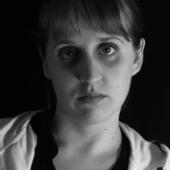Can you ever really walk in someone else’s shoes?

As I rode the Guthrie’s enormous escalator, past the ghostly images of shows past, a burst of trumpets sounded forth, announcing there were only ten minutes before the shows began, including We Are Proud to Present a Presentation About the Herero of Namibia, Formerly known as Southwest Africa, From the German Südwestafrika, Between the Years 1884-1915 by Jackie Sibblies Drury. “Proud to Present indeed,” I thought, as the fanfare faded out, and they should be. This is not the type of work the Guthrie is known for; it’s visceral, uncomfortable and utterly contemporary.
The play is part of the Guthrie’s Level Nine series, which fills the Dowling Studio with adventurous work by national and local companies and charges only nine dollars for tickets. And it seems to be working. The crowd in the studio was younger and at least a bit more rumpled than the people downstairs, one of whom was wearing a full length wool evening coat and an unironic fedora.
Drury’s piece is consciously staged as a work in progress. There’s production dramaturgy taped to the back wall with blue painter’s tape, props and boxes crowd the risers, and the audience enters with the florescent work lights on full blast. There was an aggressive nonchalance to the atmosphere: “You are not watching a normal play!” it said. “Prepare for something unusual!”
And we definitely get it as we watch an ensemble of six actors discuss how to tell the story they are telling us about the genocide of the Herero tribe. Nike Kadri, a graduate of the Guthrie’s U of M BFA program, plays Actor 6 who plays Black Woman, which she “also is in real life,” serving as artistic director of the fictional company and assumed playwright surrogate. Her poignant longing for family and her desire to tell the story right drive the piece through fascinating ideas of representation, narrative, and memory.
It’s smart and messy and funny. The black and white actors bring their own anxieties and passions to the table as they fight for control of the narrative. There were no intellectual straw men, propped up to make an easy argument. Every character has sincere beliefs and pitfalls and I found myself squirming as they inevitably, realistically clashed.
This is a hard story to tell. The only texts the company has access to are the letters from German soldiers who make no mention of the atrocities committed against the Herero. But that does not mean they didn’t happen.
Likewise, the company’s experience of memory and history is deeply unbalanced. The actor playing Another White Man has family stories about his great great grandfather, while the Herero man has had his ancestral memory forcibly extinguished. How does one find the real story? What makes a story real? And who gets to tell it?
I’m finding it tough to critique performances because the lines are so deliberately blurred between the characters, the actors who play the characters, and the actors who play those actors. The ensemble is game, skilled, and committed. Their performances are detailed, from Quinn Franzen’s effectively gross German child to Lamar Jefferson’s voguing pass and death drop, quietly echoed by Nika Ezell Pappas on the rehearsal table. Or, is Another Black Man’s voguing echoed by the unnamed White Woman/Sarah? (Because, of course, all women are Sarah.) The conscious construction and obscuring of archetypes and personal identity gives Drury space to explore enormous stories of Black People and White People but also the intimate story of a Herero couple around a fire or six actors in a room.
The production can feel a bit heavy handed at time, as if it didn’t quite trust its audience. In the opening sock puppet show (yes, there is a sock puppet show), the white German sock puppet tells the Herero paper bag puppet that they will be building a WALL, capital emphasis, prompting an “Oooh” of recognition.
The technical prowess of the Guthrie sometimes gets in the way of the experience of the story. The lights in the studio create some beautiful effects, like the glowing ghostly shadow of Sarah in the rehearsal mirror as the German soldier writes home. But at the same time they were very proscriptive, clearly differentiating rehearsal from performance when it seemed like it might be better left ambiguous.
I also wonder who this production was for. Part of the play flashed me back to the ending of the latest season of Orange is the New Black which triggered a wave of think pieces on media depictions of black pain for a white audience. The play does not fall into the same traps as the TV show, or at least does not stay in those traps. But, I did find myself thinking about how I would experience parts of this production differently as a black audience member barraged with traumatic images of violence on black bodies. There were moments that seemed exploitative, and brutal for brutality’s sake. Perhaps the distressing familiarity of the pain is the point, but I wanted to follow the idea further.
In the end, I think Drury’s piece is nuanced and visceral and specific and fascinating, but I don’t think that the Guthrie’s production serves it completely. There’s a hesitation to the metatheatrics. I never forgot that the interjections and equivocations were scripted, that the violence was staged. It kept me away from the story, and there were times when instead of feeling empathy for the characters involved, I felt uncomfortable that things were happening onstage.
In the talk back, another audience member described feeling “sucker-punched” by the piece, a cheap shot that comes out of nowhere. I think this piece could be a gut punch, deliberate, calculated and powerful. At any case, I am grateful that the big G isn’t pulling its punches with its play selection. The production isn’t perfect, but this story should reach a Guthrie audience and I am excited to see what else they have in store.




